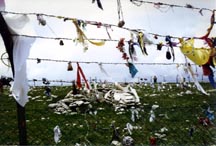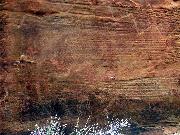|
Native American Cultural Connections
 Prayer offerings are still being left at Bighorn.
Prayer offerings are still being left at Bighorn.
|
The Bighorn Medicine Wheel remains a part of Native American ritual life
even today.
About 60 tribes visit the site annually, and conduct some 180 sacred
ceremonies there.
While Bighorn is the largest and most elaborate medicine wheel
known, dozens of similar structures lie
scattered throughout western Canada and U.S.
|
Sacred Chaco Canyon

Ancient peoples in the Chaco Canyon area of New Mexico designed their massive spiritual center
with solar alignments and markers playing dramatic and visual roles. The image at left shows
the Sundagger, a shaft of light bisecting a carved spiral at noon on the Winter Solstice.
For more information about Chaco, visit
Chaco Canyon by the Exploratorium
and Traditions of the Sun, a NASA
visual exploration of Chaco.
Native Views from Space
"Through traditional customs and symbols like the medicine wheel, a circular arrangement of stones often
interpreted as representing the relationship between Earth, air, water and fire, Native Americans have
long recognized and celebrated the connectedness among all natural things. Indeed, the Native American
view of the world has always been consistent with that of Earth system science -- that Earth is a
single system of interconnected parts." NASA's
Native Views from Space site explores interactions between Earth's various components,
including the Medicine Wheel, in a new light.
The Sun Dance
For many of the Plains Indians, including the Lakota, the
Sundance or
Wiwanyag Wachipi
was their major communal religious ceremony.
Generally held in the late spring or early summer, the rite celebrates renewal,
spiritual rebirth, and regeneration of the living Earth with all its components.
The ritual involves staring at the Sun while dancing, personal sacrifice,
and supplication to insure harmony between all living things.
There is a
symbolic role played by animals in the sundance as well.
Contemporary Native Americans continue the Sundance today
(the modern Sundance Ceremony).
|
Similar Alignments at Cohokia "Woodhenge"
When the equinoxes arrived in the ancient city of Cahokia, near present-day St. Louis,
priests watched the sunrise from inside a ring of cedar poles that served as a calendar
very similar to the Medicine Wheels.
Built by the Mississippian culture, the city of Cahokia arose around
700 AD and for hundreds of years served as the center of a huge trading network linked to other societies
of North America. Cahokia was one of the most advanced civilizations in ancient America.
It reached its zenith around 1100-1200 AD, when its population
swelled to as much as 20,000.
Cohokian inhabitants built a series of large calendrical circles ringed with wooden poles. These
may have served a similar function to the Medicine Wheels.
Instead of stone, Cahokians used red cedar posts 15 to 20 inches in diameter and about 20 feet long.
Each circle consisted of a central Sun-watching station, surrounded by a ring of cedar poles.
Watching from the center, a priest would see the Sun aligned with the poles on the solstices, equinoxes,
and other important solar dates.
Archaeologists have named these circles Woodhenges because of their resemblance to England's Stonehenge.
Cohokians eventually faced a series of problems driven by overpopulation, poor environmental practices
(including cutting down all their trees), and a change in climate. By 1400, the city was abandonded.
Learn more about Cahokia at Ancient Cohokia
(a site by the Washington Post).
|

Oral Traditions and the Medicine Wheels:
Native Americans relied almost solely on oral traditions to pass along important knowledge through the generations.
Very little is known about the origins of the Medicine Wheels because much of the history and
these oral traditions have been lost.
Some say that medicine wheels were a guide from the heavens to build the first tipis.
Other legends note that they were built "before the light came."
One Crow story speaks of a man named Scarface:
"Scarface was handsome and was fond of strutting in his finery before young women.
One day while entering his mother's tipi, he fell into the fire which severely burned
his face and was thereafter embarrassed to be seen. Shamed at his appearance,
he left his people and went to live in the mountains. Scarface lived alone for many years.
One day while a young woman and her grandmother were hunting berries,
they became separated from their people and couldn't find their way back.
They traveled along a trail which took them into the mountains.
They occasionally saw Scarface and one day made contact with him. Scarface
later married the young woman. On their travels back to his people,
Scarface supposedly built the Medicine Wheel as their shelter.
On the second day he built another tipi by the Bighorn river in the valley below.
The tipi rings are believed to still exist."
Tale from Bighorn Medicine Wheel
Many claim that the Medicine Wheels symbolize all creation, all peoples and all animals.
It's circular shape echoes the cycles of the Earth, Sun, seasons, and life.
|

Beliefs about the Sun and Stars by the Plains Indians:
The Lakota Sioux call the Sun "Wiyo ate" and say
"The light of the sun enlightens the entire universe,
and as the flames of the sun come to us in the morning, so comes the grace of
Wakan Tanka,
by which all creatures are enlightened.
It is because of this that the four-leggeds and the wingeds always rejoice at the coming
of the light. We can all see in the day, and this seeing
is sacred for it represents the sight of that real world which
we may have through the eye of the heart."
Black Elk
To these same people, the stars (Wichahpi) are
wakan -- holy, sacred, powerful, and mysterious.
"Sometimes they come to the world and sometimes the Lakotas go to them.
There is one star for the evening and one for the morning.
One star never moves [the North Star]; other stars move in a circle about it.
They are dancing in the dance circle.
There are seven stars. This is why there are seven council fires among the Lakotas.
The Spirit Way is among the stars. It begins at the edge of the world. No man can find it.
Wakan Tanka keeps the bad spirits away from the Spirit Way."
Ringing Shield

|
Back to Ancient Observatories -- Timeless Knowledge
Image credits:
- Photo of prayer offerings at Bighorn by Deborah Scherrer.
- Sundagger image by The Solstice Project; used with permission.
- Petroglyph photograph, with color enhancement, by Deborah Scherrer, Chaco Canyon.
- Sunrise at Chaco photograph by Deborah Scherrer.
- Elaborate solar (?) petroglyph photograph by Deborah Scherrer, Chaco Canyon.
©2005-2023 by Stanford SOLAR Center |
Permitted Uses |
Credits
|

